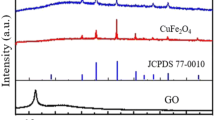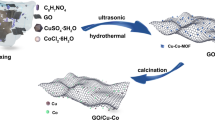Abstract
Carbon material has been designed as substrate to improve the sensitivity characteristics of copper azide (Cu(N3)2), lots of research findings have supported this strategy. However, the thermal decomposition mechanism of Cu(N3)2 nanocomposite has not yet been revealed. In this work, graphene was used as a composite material to prepare a Cu(N3)2/graphene composite primary explosive. Differential scanning calorimeter (DSC) and thermogravimetric-infrared spectroscopy (TG-DSC-FTIR) were used to analyse its thermal decomposition performance. The results showed that the composite of graphene could delay the decomposition point of Cu(N3)2 to 215.49 °C, indicating that the heat release of composite copper azide was concentrated, and the thermal decomposition rate was accelerated. The thermal decomposition reaction kinetic results indicated that the thermal decomposition of Cu(N3)2/graphene accord with the Avrami–Erofeev equation (No. 11 Mechanism Function), and its Apparent Activation Energy (Ea) was 113.42 kJ/mol, and the exponential factor log A was 9.26 s−1.
Access this chapter
Tax calculation will be finalised at checkout
Purchases are for personal use only
Similar content being viewed by others
References
B.L. Evans, A.D. Yoffe, P. Gray, Physics and chemistry of the inorganic azides. Chem. Rev. 59, 515–568 (1959)
F. Zhang, Y. Wang, D. Fu et al., In-situ preparation of a porous copper based nano-energetic composite and its electrical ignition properties. Propel. Explos. Pyrotech. 38, 41–47 (2013)
L. Zhang, F. Zhang, Y. Wang, R. Han, J. Chen, R. Zhang, E. Chu, In-situ preparation of copper azide by direct ink writing. Mater. Lett. 238, 130–133 (2019)
Y. Shen, J. Xu, N. Li et al., A micro-initiator realized by in-situ synthesis of three-dimensional porous copper azide and its ignition performance. J. Chem. Eng. J. 326, 1116–1124 (2017)
H. Pezous, C. Rossi, M. Sanchez et al., Integration of a MEMS based safe arm and fire device. Sens. Actuators A Phys. 159, 157–167 (2010)
C. Rossi, D. Esteve, Micropyrotechnics, a new technology for making energetic microsystems: review and prospective. Sens. Actuators A Phys. 120, 297–310 (2005)
A.B. Gordienko, A.S. Poplavno, Electronic structure of CuN3(I). Phys. Solid State 48(10), 1844–1847 (2006)
T. Lindblom, H. Malmberg, Analysis of copper azide in ammunition using FTIR, in 12th Symposium on Chemical Problems Connected with the Stability of Explosives (2001)
I. Kabik, S. Uman, Hazards of copper azide fuzes, in Proceedings of Minutes of the 14th Explosive Safety Seminar (US, 1972)
M. Robert, P. Jiri, Primary Explosives (Springer, Berlin, 2013), pp. 71–120
Z.M. Li, M.R. Zhou, T.L. Zhang et al., The facile synthesis of graphene nanoplatelet–lead styphnate composites and their depressed electrostatic hazards. J. Mater. Chem. A 1(41), 12710–12714 (2013)
J.W. Fronabarger, M.D. Williams, W.B. Sanborn et al., DBX-1—a lead free replacement for lead azide. Propel. Explos. Pyrotech. 36, 541–550 (2011)
V. Thottempudi, H. Gao, J.M. Shreeve, Trinitromethyl-substituted 5-nitro- or 3-azo-1,2,4-triazoles: synthesis, characterization, and energetic properties. J. Am. Chem. Soc. 133, 6464–6471 (2011)
B.T. Fedoroff, O.E. Sheffield, S.M. Kaye, Encyclopedia of Explosives and Related Items (Picatinny Arsenal, Dover, NJ, 1983)
M. Zhou, Z. Li, Z. Zhou et al., Antistatic modification of lead styphnate and lead azide for surfactant applications. Propel. Explos. Pyrotech. 38, 569–576 (2013)
M. Hu, The effect of tetrazene on the reliability of some stab detonator. Initiat. Pyrotechn. 32–34 (2016)
C. Yu, Z. Zheng, W. Zhang et al., Sustainable electrosynthesis of porous CuN3 films for functional energetic chips. ACS Sustain. Chem. Eng. 8, 3969–3975 (2020)
B. Li, M. Li, Q. Zeng et al., In situ fabrication of monolithic copper azide. J. Energetic Mater. 34, 123–128 (2016)
Q. Wang, X. Feng, S. Wang et al., Metal-organic framework templated synthesis of copper azide as the primary explosive with low electrostatic sensitivity and excellent initiation ability. J. Adv. Mater. 28, 5837–5843 (2016)
Q. Wang, L. Zhang, W. He et al., High-performance primary explosives derived from copper thiolate cluster-assembled materials for micro-initiating device. Chem. Eng. J. 389, 124455 (2020)
V. Pelletier, S. Bhattacharyya, I. Knoke et al., Copper azide confined inside templated carbon nanotubes. Adv. Funct. Mater. 20, 3168–3174 (2010)
X. Liu, Y. Hu, H. Wei et al., Energetic films realized by encapsulating copper azide in silicon-based carbon nanotube arrays with higher electrostatic safety. Micromachines 11, 575 (2020)
C. Yu, W. Zhang, S. Guo et al., A safe and efficient liquid-solid synthesis for copper azide films with excellent electrostatic stability. Nano Energy 66, 104135 (2019)
H. Pezous, C. Rossi, M. Sanchez et al., Fabrication, assembly and tests of a MEMS-based safe, arm and fire device. J. Phys. Chem. Solids 71(2), 75–79 (2010)
Q. Yu, M. Li, Q. Zeng et al., Copper azide prepared by reaction of hollow CuO microspheres with moist HN3 gas. Mater. Lett. 224, 18–21 (2018)
Q. Yu, M. Li, Q. Zeng et al., Copper azide fabricated by nanoporous copper precursor with proper density. Appl. Surf. Sci. 442, 38–44 (2018)
G. Zhang, J. Han, L. Yang et al., Theoretical study of the reduction in sensitivity of copper azide following encapsulation in carbon nanotubes. J. Mol. Model. 26, 90 (2020)
L. Zhang, L. Yang, F. Zhang et al., In situ synthesis of three-dimensional graphene skeleton copper azide with tunable sensitivity performance. Mater. Lett. 279, 128466 (2020)
H. Kissinger, Reaction kinetics in differential thermal analysis. Anal. Chem. 29(11), 1702–1706 (1957)
T. Ozawa, A method of analyzing thermogravimetric data. Bull. Chem. Soc. Jpn. 38(11), 1881–1886 (1965)
Author information
Authors and Affiliations
Corresponding author
Editor information
Editors and Affiliations
Rights and permissions
Copyright information
© 2022 China Ordnance Society
About this paper
Cite this paper
Chen, J. et al. (2022). Study on Preparation and Thermal Decomposition Performance of Copper Azide/Graphene Nanocomposite. In: Gany, A., Fu, X. (eds) 2021 International Conference on Development and Application of Carbon Nanomaterials in Energetic Materials. ICCN 2021. Springer Proceedings in Physics, vol 276. Springer, Singapore. https://doi.org/10.1007/978-981-19-1774-5_23
Download citation
DOI: https://doi.org/10.1007/978-981-19-1774-5_23
Published:
Publisher Name: Springer, Singapore
Print ISBN: 978-981-19-1773-8
Online ISBN: 978-981-19-1774-5
eBook Packages: Physics and AstronomyPhysics and Astronomy (R0)




